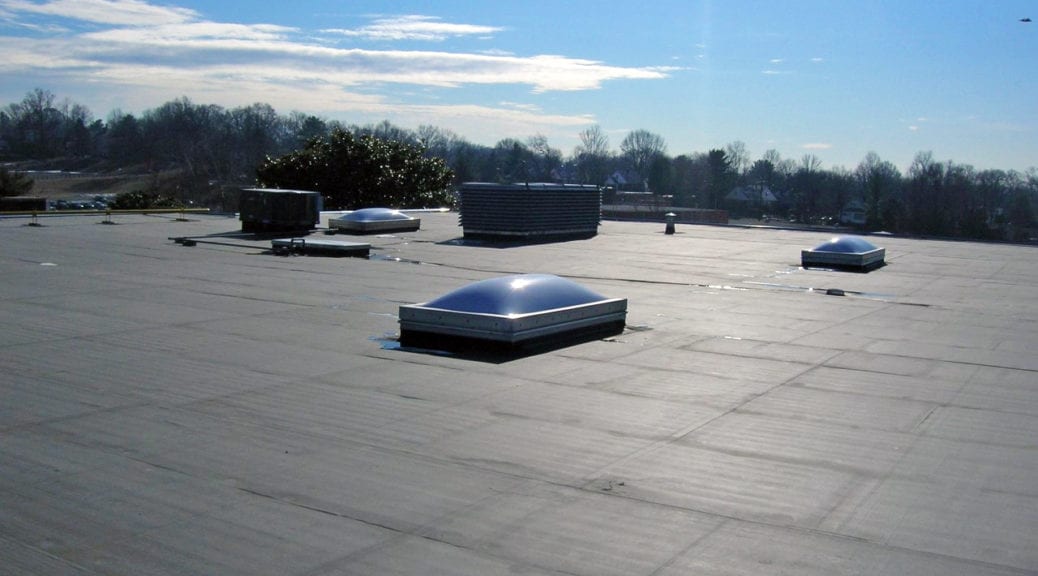Here at Heidler Roofing, one of our primary goals in business is making sure commercial buildings throughout the Mid-Atlantic region have the best and most protective roofing systems. If you’ve been following along with our recent Ultimate Guide to Commercial Roofing blog post series, we hope that’s obvious by now!
With so many choices on the market today, does the color matter? The answer is yes. Your commercial roof’s color absolutely matters—and not just for aesthetic reasons. The material it’s constructed from makes a huge difference in its performance capabilities, and the color is closely related to the material when you’re talking about single-ply membrane systems.
So, what are the differences between the most popular types of single-ply materials for new installations and replacement applications?
Today’s post compares single-ply thermoset materials like EPDM, which is typically black, and thermoplastic materials—TPO & PVC—which tend to be white. Which should you choose? We’ll help you consider that question, too.
About Thermoset Materials – EPDM
EPDM, which stands for Ethylene Propylene Diene Monomer, is a rubber-like material that has excellent “cyclical membrane fatigue resistance.” In plain English, this means that regular day-to-day and seasonal temperature changes do not cause it to wear out quickly. This is because EPDM does not change shape at the influence of heating or cooling. It remains quite flexible whether it’s 2 degrees outside in February or 92 degrees in July thanks to its thermoset nature.
Like all single-ply roofing, EPDM comes in sheet rolls, which means it installs relatively quickly. It is adhered with appropriate high-strength tapes or adhesives, and once the system is in place, it creates a strong, highly waterproof barrier between Mother Nature’s harshest elements and your building’s interior.
Why Consider EPDM?
You live in a region with severe weather threats
Beyond fatigue resistance and overall strength, EPDM is well known to be impact resistant. This means it presents a robust defense against threats like smaller-size hail and minor windblown debris from storms.
Additionally, when EPDM systems are designed correctly, they are wind resistant. In fact, EPDM is compliant with stringent building codes in hurricane-prone regions like Florida. If your building’s roof has sustained storm damage in the past, this fact may be a crucial consideration for you.
You want a material that’s been proven durable
EPDM roofing is a relatively “mature” single-ply membrane technology that’s been on the market for 40+ years at this point. In those years, the material has been shown to have excellent longevity. As we noted in our Ultimate Guide chapter with answers to FAQs about flat and low-slope commercial roofing systems, you can expect EPDM roof systems to last for up to 30 years if properly maintained.
About Thermoplastic Materials – TPO & PVC
In many ways, thermoplastic single-ply roofing is the opposite of EPDM—at least in terms of how it’s made. TPO (thermoplastic polyolefin) and PVC (polyvinyl chloride) materials change shape with temperature shifts, and they are often white/reflective in appearance.
Interestingly, though, these systems can achieve similar durability and provide an equally long list of advantages to thermoset options.
Why Consider TPO or PVC?
You need good chemical resistance
One of the big benefits that thermoplastic materials offer over other systems is resistance to chemicals and bacteria, including oils and animal fats. Depending on what business activities you conduct within your building, this could be extremely important to the durability of your roofing system.
Being “cool” matters to you
Because TPO & PVC roofing is white in color, these materials go into creating “cool” roofs. Cool roofing can control temperatures in and around the buildings they cover when properly installed. Natural reflectivity makes these materials more energy-efficient than black roofs, especially in places where bright sunlight and high summertime or year-round temperatures drive up cooling costs.
Is One Material Better Than the Other?
As with any commercial roofing material or system you’re considering, it’s not really about whether one is inherently better than another. Some materials are simply a better choice for your particular building and the business you conduct inside.
If you’re considering thermoplastic single-ply membranes, we can help you determine whether PVC or TPO might be your best choice depending on budgetary and other factors.
TPO & PVC Durability/Longevity vs. EPDM
Although structurally different from EPDM/thermoset options, TPO and PVC roofing materials are generally just as long-lived with proper preventative maintenance. Thermoplastic material technology is a bit newer than EPDM, as well, but it has been proving itself to be impressively strong and durable—especially here in our home region throughout the Mid-Atlantic and Northeast United States.
Is a Single-Ply Membrane System Right for Your Roof?
As we have often talked about here on the blog, choosing the best roof for your commercial building involves careful consideration and decision-making.
You need to account for factors like weather and local climate conditions that your building is exposed to, your building’s general architecture and construction (your commercial roof may also be a specialty roof), and even what your business does or makes. Manufacturing operations are much different than retail stores, for instance, and that will absolutely affect your roofing needs.
Single-ply membrane systems are great for a range of business and building types, but you need to consult an expert commercial roofing resource like Heidler Roofing to get the best performance from your roof. If you’re ready to begin a commercial roofing project, or just have questions about single-ply membranes vs. other material options, get in touch with us today!


